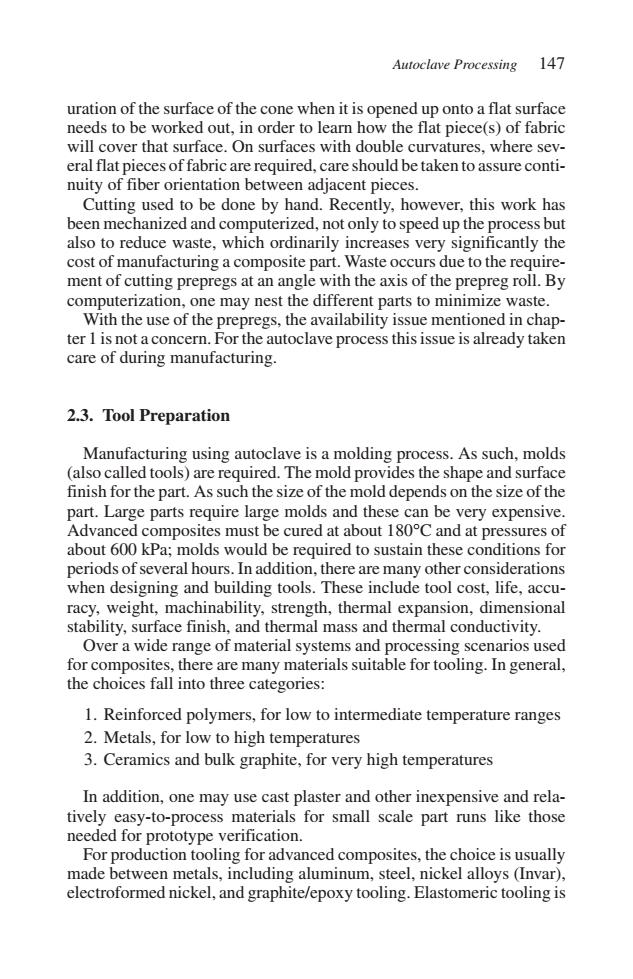正在加载图片...

Autoclave Processing 147 uration of the surface of the cone when it is opened up onto a flat surface needs to be worked out,in order to learn how the flat piece(s)of fabric will cover that surface.On surfaces with double curvatures,where sev- eral flat pieces of fabric are required,care should be taken to assure conti- nuity of fiber orientation between adjacent pieces. Cutting used to be done by hand.Recently,however,this work has been mechanized and computerized,not only to speed up the process but also to reduce waste,which ordinarily increases very significantly the cost of manufacturing a composite part.Waste occurs due to the require- ment of cutting prepregs at an angle with the axis of the prepreg roll.By computerization,one may nest the different parts to minimize waste. With the use of the prepregs,the availability issue mentioned in chap- ter 1 is not a concern.For the autoclave process this issue is already taken care of during manufacturing 2.3.Tool Preparation Manufacturing using autoclave is a molding process.As such,molds (also called tools)are required.The mold provides the shape and surface finish for the part.As such the size of the mold depends on the size of the part.Large parts require large molds and these can be very expensive. Advanced composites must be cured at about 180C and at pressures of about 600 kPa;molds would be required to sustain these conditions for periods of several hours.In addition,there are many other considerations when designing and building tools.These include tool cost,life,accu- racy,weight,machinability,strength,thermal expansion,dimensional stability,surface finish,and thermal mass and thermal conductivity. Over a wide range of material systems and processing scenarios used for composites,there are many materials suitable for tooling.In general, the choices fall into three categories: 1.Reinforced polymers,for low to intermediate temperature ranges 2.Metals,for low to high temperatures 3.Ceramics and bulk graphite,for very high temperatures In addition,one may use cast plaster and other inexpensive and rela- tively easy-to-process materials for small scale part runs like those needed for prototype verification. For production tooling for advanced composites,the choice is usually made between metals,including aluminum,steel,nickel alloys (Invar), electroformed nickel,and graphite/epoxy tooling.Elastomeric tooling isuration of the surface of the cone when it is opened up onto a flat surface needs to be worked out, in order to learn how the flat piece(s) of fabric will cover that surface. On surfaces with double curvatures, where several flat pieces of fabric are required, care should be taken to assure continuity of fiber orientation between adjacent pieces. Cutting used to be done by hand. Recently, however, this work has been mechanized and computerized, not only to speed up the process but also to reduce waste, which ordinarily increases very significantly the cost of manufacturing a composite part. Waste occurs due to the requirement of cutting prepregs at an angle with the axis of the prepreg roll. By computerization, one may nest the different parts to minimize waste. With the use of the prepregs, the availability issue mentioned in chapter 1 is not a concern. For the autoclave process this issue is already taken care of during manufacturing. 2.3. Tool Preparation Manufacturing using autoclave is a molding process. As such, molds (also called tools) are required. The mold provides the shape and surface finish for the part. As such the size of the mold depends on the size of the part. Large parts require large molds and these can be very expensive. Advanced composites must be cured at about 180°C and at pressures of about 600 kPa; molds would be required to sustain these conditions for periods of several hours. In addition, there are many other considerations when designing and building tools. These include tool cost, life, accuracy, weight, machinability, strength, thermal expansion, dimensional stability, surface finish, and thermal mass and thermal conductivity. Over a wide range of material systems and processing scenarios used for composites, there are many materials suitable for tooling. In general, the choices fall into three categories: 1. Reinforced polymers, for low to intermediate temperature ranges 2. Metals, for low to high temperatures 3. Ceramics and bulk graphite, for very high temperatures In addition, one may use cast plaster and other inexpensive and relatively easy-to-process materials for small scale part runs like those needed for prototype verification. For production tooling for advanced composites, the choice is usually made between metals, including aluminum, steel, nickel alloys (Invar), electroformed nickel, and graphite/epoxy tooling. Elastomeric tooling is Autoclave Processing 147